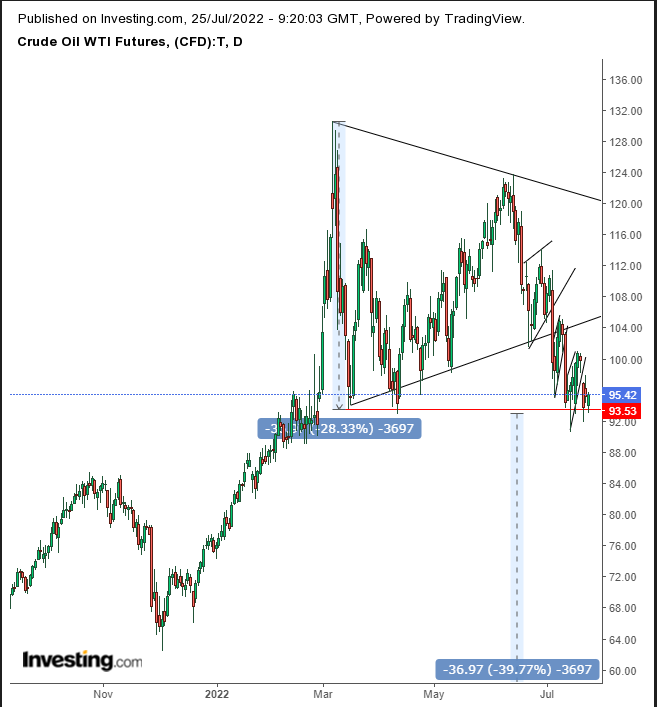In less than six week, oil is down 29%. Since the June 14 peak, it has almost erased all the gains since Russia's invasion of Ukraine on February 24. If anyone continues to think we are not going into a recession—if we're not in one already—consider the following.
The Russian invasion of Ukraine and the ensuing energy crisis in Europe which pushed oil to its highest level since 2008 has been erased because of concerns of a global recession.
So, what does that look like on the chart?

In mid-June, US President Joseph Biden sent refineries and producers a scathing letter, accusing their profits of being "well above normal." Traders sold off which pushed the oil prices down a whopping 22%, from the June 4 high to the June 22 low.
But some investors could not believe their luck and quickly cashed in profits. Those short coverings reduced supply and increased demand, pushing the price back up.
When the price broke the bottom side of the flag, it showed that the demand was temporary—consistent with a short squeeze—and that sellers controlled the market.
Oil plunged 10% on July 5 on increased recession fears despite no new data being released that day. Simply demand was drowned out by supply and sellers were forced to compromise their ask and find new, more discerning buyers at lower prices.
That plunge, a flag pole in technical speak, conceived a second Rising Flag. Again, short sellers didn't want to overplay their luck and locked in profits, creating the body of the Rising Flag.
Then, oil plunged another 8.5% on July 12 for the same stated reason—recession fears. Commentators attributed the fall to ongoing COVID restrictions in China, but there was no significant coronavirus-related news that day. The only fundament news related development was that OPEC forecast strong oil demand that might test its output capacity. This is ironic because it is diametrically opposed to the previously stated fundamental reason for falling oil prices—that recession will hit demand.
That selloff was the third flag pole that preceded the third Rising Flag.
Each Rising Flag is a reflection of consistent and repeating supply while at the same time luring in more and more supply.
The implied target of each flag is a repeat of its flagpole. The assumption is that all the correct traders have been incentivized to repeat their actions; the wrong traders now know better, and those sitting on the sidelines don't want to miss out next time.
Arguably, each additional flag compounds those dynamics in terms of trade orders and psychological impact.
At the same time, the previous trading pattern already completed a Symmetrical Triangle, with an implied target of $66.
However, if the price rises to $101 and falls below $90, it will also have completed a Descending Triangle. The latter is innately bearish, as it shows that sellers are becoming more desperate than buyers, as they reduce their bids with each major sale, while buyers were only willing to buy at the same consistent price.
Also, since the Symmetrical Triangle breakout was around $103, and the Descending Triangle's breakout would be $10 lower, it would deepen the target. So, while my Symmetrical Triangle's implied target was a $36 drop from its $103 breakout point, aiming at $66, the Descending Triangle's implied target of $36 lower than the $93 breakout point is $56.
Trading Strategies
Conservative traders should wait for the price to trigger a return move at least to the final flag and demonstrate resistance before risking a short position.
Moderate traders would wait for the return move to reduce exposure if not for confirmation.
Aggressive traders could enter a contrarian long-position, counting on a rebound off the lows going back to mid-March before joining other traders in a short.
Trade Sample 1 - Aggressive Long Position:
- Entry: $91
- Stop-Loss: $90
- Risk: $1
- Target: $98
- Reward: $7
- Risk-Reward Ratio: 1:7
Trade Sample 2 - Moderate Short Position:
- Entry: $100
- Stop-Loss: $101
- Risk: $1
- Target: $90
- Risk-Reward Ratio: 1:10
Disclaimer: The author currently does not own any of the securities mentioned in this article.
